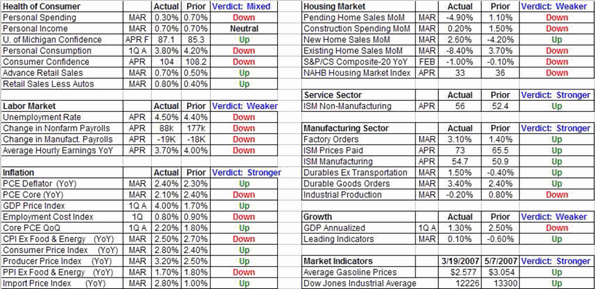| Will the Federal Reserve Help the Dollar? |
| By Kathy Lien |
Published
05/8/2007
|
Currency
|
Unrated
|
|
|
|
Will the Federal Reserve Help the Dollar?
Federal Reserve Meeting: Is USD/JPY or EUR/USD Better to Trade?
The Federal Reserve's interest rate meeting scheduled for Wednesday is one of the financial market's biggest event risks this week. Traders have taken the US dollar higher going into the meeting and the Dow Jones Industrial Average slightly lower, indicating that the market is favoring a more hawkish outcome. Interest rates are not expected to be changed and will be left at 5.25 percent. The Federal Reserve has not changed interest rates since June 2006. Over the past 11 months, traders have been scrutinizing the FOMC statement for every word that has been newly included or excluded to try to time the next movement by the Fed. Unfortunately more than a year will pass before we actually see some action from the central bank. This attitude has been a major contributor to the EUR/USD's move from 1.27 in June to its present level above 1.35. Since the beginning of the year, we have seen nothing but dollar weakness and we are finally seeing some sign of strength, but traders have been hesitant to take the dollar much higher before hearing what the Fed has to say. Which currency pair to trade in reaction to the FOMC statement will depend upon how the Fed sways. A cautious statement would probably lead to more pronounced dollar weakness against the Euro than the Japanese Yen because the market anticipates another rate hike from the European Central Bank in June. Shorting USD/JPY would still require paying hefty interest. An unchanged statement or one that downplays the recent deterioration in growth to focus on the upside inflation risks will probably lead to more dollar strength against the Yen than the Euro due to the more beneficial carry.
US Economic Data: How Have Things Changed Since the Last Meeting?
For those who want to lay on currency trades going into the meeting, it is important to examine how the most recent data since the last monetary policy meeting on March 20/21 stack up:

As indicated by the data tables above, growth is weaker and both the labor and housing markets deteriorated. Inflation has been strong while service and manufacturing sector growth have benefited from the weakness of the US dollar. The health of the consumer has been mixed but remember the latest official spending data is from March. Even though those numbers reflect strength, recent sales reports from retailers such as Dress Barn, Sears Holdings, Talbots and Targets have all been weak. This puts the Fed in a difficult place as average gasoline prices hit a record high at a time when economic growth dropped to a 4 year low.
What Will Team Bernanke Do?
The last FOMC statement contained a number of interesting changes. The Fed acknowledged that the economy was beginning to weaken going into the meeting but stressed that their "predominant" concern was that inflation would fail to moderate. In the box below, we have highlighted the major changes to the last statement. Since then, inflation has increased due to the weakness of the dollar and rising gasoline prices. Therefore even though we think that growth data warrants more cautionary comments, the Fed will most likely wait for a few more weeks of data to ensure that the deterioration in growth is continuing before they drastically change the tune of their statement. Their next monetary policy meeting is in late June. The tug of war between inflation and growth at the moment gives the Fed little room to alter the FOMC statement. Team Bernanke has often put inflation ahead of growth and for the time being, we do not expect this to change. The futures curve is not pricing in a rate cut until the end of the year. Keeping interest rates steady and the statement unchanged will be taken positively by the foreign exchange market, which his could lead to a resumption of the uptrend in USD/JPY. A surprisingly neutral or dovish statement on the other hand will send the EUR/USD back towards its all-time highs.
Comparing the Last 2 FOMC Statements
March 21, 2007 FOMC Statement
The Federal Open Market Committee decided today to keep its target for the federal funds rate at 5-1/4 percent.
Recent indicators have been mixed and the adjustment in the housing sector is ongoing. Nevertheless, the economy seems likely to continue to expand at a moderate pace over coming quarters.
Recent readings on core inflation have been somewhat elevated. Although inflation pressures seem likely to moderate over time, the high level of resource utilization has the potential to sustain those pressures.
In these circumstances, the Committee's predominant policy concern remains the risk that inflation will fail to moderate as expected. Future policy adjustments will depend on the evolution of the outlook for both inflation and economic growth, as implied by incoming information.
Jan 31, 2007 FOMC Statement
The Federal Open Market Committee decided today to keep its target for the federal funds rate at 5-1/4 percent.
Recent indicators have suggested somewhat firmer economic growth, and some tentative signs of stabilization have appeared in the housing market. Overall, the economy seems likely to expand at a moderate pace over coming quarters.
Readings on core inflation have improved modestly in recent months, and inflation pressures seem likely to moderate over time. However, the high level of resource utilization has the potential to sustain inflation pressures.
The Committee judges that some inflation risks remain. The extent and timing of any additional firming that may be needed to address these risks will depend on the evolution of the outlook for both inflation and economic growth, as implied by incoming information.
Kathy Lien is the Chief Currency Strategist at FXCM.
|